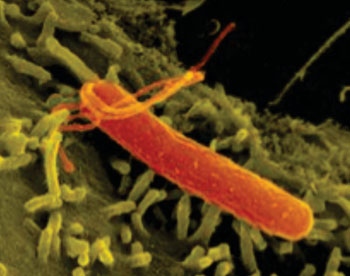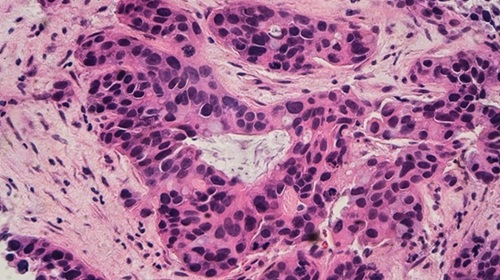Suppression of DNA Repair by H. pylori Paves the Way for Development of Gastric Cancer
|
By LabMedica International staff writers Posted on 28 Jun 2015 |

Image: The stomach bacterium Helicobacter pylori changes the activity of genes in gastric cells (Photo courtesy of Max Planck Institute for Infection Biology).
A team of molecular microbiologists has established what they believe to be the definitive link between Helicobacter pylori infection and the development of gastric cancer.
Infection with the human pathogen H. pylori is a major risk factor for gastric cancer. However, since the bacterium exerts multiple genotoxic effects, investigators at the Max Planck Institute for Infection Biology (Berlin, Germany) chose to examine how DNA damage accumulated in gastric cells following H. pylori infection.
The investigators utilized a new technique for cultivating cultures of normal human stomach tissue. This material replaced the use of cancer cell lines whose mutated genomes obscured early changes induced by H. pylori.
Results published in the June 11, 2015, online edition of the journal Cell Reports revealed that the activity of several sub-telomeric genes responsible for recognizing and repairing damaged DNA was suppressed during the course of the infection. Infection impaired several host cell DNA repair factors, the extent of which depended on a functional H. pylori cag pathogenicity island (cagPAI). This led to accumulation of a unique DNA damage pattern, preferentially in transcribed regions and proximal to telomeres, in both gastric cell lines and primary gastric epithelial cells. The observed pattern correlated with focal amplifications in adenocarcinomas of the stomach and partly overlapped with known cancer genes.
They authors described their interpretation of the impact of H. pylori infection on host cell DNA by saying, "We thus demonstrate an impact of a bacterial infection directed toward specific host genomic regions and describe underlying characteristics that make such regions more likely to acquire heritable changes during infection, which could contribute to cellular transformation."
Related Links:
Max Planck Institute for Infection Biology
Infection with the human pathogen H. pylori is a major risk factor for gastric cancer. However, since the bacterium exerts multiple genotoxic effects, investigators at the Max Planck Institute for Infection Biology (Berlin, Germany) chose to examine how DNA damage accumulated in gastric cells following H. pylori infection.
The investigators utilized a new technique for cultivating cultures of normal human stomach tissue. This material replaced the use of cancer cell lines whose mutated genomes obscured early changes induced by H. pylori.
Results published in the June 11, 2015, online edition of the journal Cell Reports revealed that the activity of several sub-telomeric genes responsible for recognizing and repairing damaged DNA was suppressed during the course of the infection. Infection impaired several host cell DNA repair factors, the extent of which depended on a functional H. pylori cag pathogenicity island (cagPAI). This led to accumulation of a unique DNA damage pattern, preferentially in transcribed regions and proximal to telomeres, in both gastric cell lines and primary gastric epithelial cells. The observed pattern correlated with focal amplifications in adenocarcinomas of the stomach and partly overlapped with known cancer genes.
They authors described their interpretation of the impact of H. pylori infection on host cell DNA by saying, "We thus demonstrate an impact of a bacterial infection directed toward specific host genomic regions and describe underlying characteristics that make such regions more likely to acquire heritable changes during infection, which could contribute to cellular transformation."
Related Links:
Max Planck Institute for Infection Biology
Latest BioResearch News
- Genome Analysis Predicts Likelihood of Neurodisability in Oxygen-Deprived Newborns
- Gene Panel Predicts Disease Progession for Patients with B-cell Lymphoma
- New Method Simplifies Preparation of Tumor Genomic DNA Libraries
- New Tool Developed for Diagnosis of Chronic HBV Infection
- Panel of Genetic Loci Accurately Predicts Risk of Developing Gout
- Disrupted TGFB Signaling Linked to Increased Cancer-Related Bacteria
- Gene Fusion Protein Proposed as Prostate Cancer Biomarker
- NIV Test to Diagnose and Monitor Vascular Complications in Diabetes
- Semen Exosome MicroRNA Proves Biomarker for Prostate Cancer
- Genetic Loci Link Plasma Lipid Levels to CVD Risk
- Newly Identified Gene Network Aids in Early Diagnosis of Autism Spectrum Disorder
- Link Confirmed between Living in Poverty and Developing Diseases
- Genomic Study Identifies Kidney Disease Loci in Type I Diabetes Patients
- Liquid Biopsy More Effective for Analyzing Tumor Drug Resistance Mutations
- New Liquid Biopsy Assay Reveals Host-Pathogen Interactions
- Method Developed for Enriching Trophoblast Population in Samples
Channels
Clinical Chemistry
view channel
Chemical Imaging Probe Could Track and Treat Prostate Cancer
Prostate cancer remains a leading cause of illness and death among men, with many patients eventually developing resistance to standard hormone-blocking therapies. These drugs often lose effectiveness... Read more
Mismatch Between Two Common Kidney Function Tests Indicates Serious Health Problems
Creatinine has long been the standard for measuring kidney filtration, while cystatin C — a protein produced by all human cells — has been recommended as a complementary marker because it is influenced... Read moreMolecular Diagnostics
view channel
Blood Protein Profiles Predict Mortality Risk for Earlier Medical Intervention
Elevated levels of specific proteins in the blood can signal increased risk of mortality, according to new evidence showing that five proteins involved in cancer, inflammation, and cell regulation strongly... Read more
First Of Its Kind Blood Test Detects Gastric Cancer in Asymptomatic Patients
Each year, over 1 million people worldwide are diagnosed with gastric (stomach) cancer, and over 800,000 people die of the disease. It is among the top 5 deadliest cancers worldwide for both men and women.... Read moreHematology
view channel
Platelet Activity Blood Test in Middle Age Could Identify Early Alzheimer’s Risk
Early detection of Alzheimer’s disease remains one of the biggest unmet needs in neurology, particularly because the biological changes underlying the disorder begin decades before memory symptoms appear.... Read more
Microvesicles Measurement Could Detect Vascular Injury in Sickle Cell Disease Patients
Assessing disease severity in sickle cell disease (SCD) remains challenging, especially when trying to predict hemolysis, vascular injury, and risk of complications such as vaso-occlusive crises.... Read more
ADLM’s New Coagulation Testing Guidance to Improve Care for Patients on Blood Thinners
Direct oral anticoagulants (DOACs) are one of the most common types of blood thinners. Patients take them to prevent a host of complications that could arise from blood clotting, including stroke, deep... Read moreImmunology
view channel
Gene Signature Test Predicts Response to Key Breast Cancer Treatment
DK4/6 inhibitors paired with hormone therapy have become a cornerstone treatment for advanced HR+/HER2– breast cancer, slowing tumor growth by blocking key proteins that drive cell division.... Read more
Chip Captures Cancer Cells from Blood to Help Select Right Breast Cancer Treatment
Ductal carcinoma in situ (DCIS) accounts for about a quarter of all breast cancer cases and generally carries a good prognosis. This non-invasive form of the disease may or may not become life-threatening.... Read moreMicrobiology
view channel
Rapid Assay Identifies Bloodstream Infection Pathogens Directly from Patient Samples
Bloodstream infections in sepsis progress quickly and demand rapid, precise diagnosis. Current blood-culture methods often take one to five days to identify the pathogen, leaving clinicians to treat blindly... Read more
Blood-Based Molecular Signatures to Enable Rapid EPTB Diagnosis
Extrapulmonary tuberculosis (EPTB) remains difficult to diagnose and treat because it spreads beyond the lungs and lacks easily accessible biomarkers. Despite TB infecting 10 million people yearly, the... Read more
15-Minute Blood Test Diagnoses Life-Threatening Infections in Children
Distinguishing minor childhood illnesses from potentially life-threatening infections such as sepsis or meningitis remains a major challenge in emergency care. Traditional tests can take hours, leaving... Read more
High-Throughput Enteric Panels Detect Multiple GI Bacterial Infections from Single Stool Swab Sample
Gastrointestinal (GI) infections are among the most common causes of illness worldwide, leading to over 1.7 million deaths annually and placing a heavy burden on healthcare systems. Conventional diagnostic... Read morePathology
view channel
AI Tool Rapidly Analyzes Complex Cancer Images for Personalized Treatment
Complex digital biopsy images that typically take an expert pathologist up to 20 minutes to assess can now be analyzed in about one minute using a new artificial intelligence (AI) tool. The technology... Read more
Diagnostic Technology Performs Rapid Biofluid Analysis Using Single Droplet
Diagnosing disease typically requires milliliters of blood drawn at clinics, depending on needles, laboratory infrastructure, and trained personnel. This process is often painful, resource-intensive, and... Read moreTechnology
view channel
AI Saliva Sensor Enables Early Detection of Head and Neck Cancer
Early detection of head and neck cancer remains difficult because the disease produces few or no symptoms in its earliest stages, and lesions often lie deep within the head or neck, where biopsy or endoscopy... Read more
AI-Powered Biosensor Technology to Enable Breath Test for Lung Cancer Detection
Detecting lung cancer early remains one of the biggest challenges in oncology, largely because current tools are invasive, expensive, or unable to identify the disease in its earliest phases.... Read moreIndustry
view channel
Abbott Acquires Cancer-Screening Company Exact Sciences
Abbott (Abbott Park, IL, USA) has entered into a definitive agreement to acquire Exact Sciences (Madison, WI, USA), enabling it to enter and lead in fast-growing cancer diagnostics segments.... Read more
























